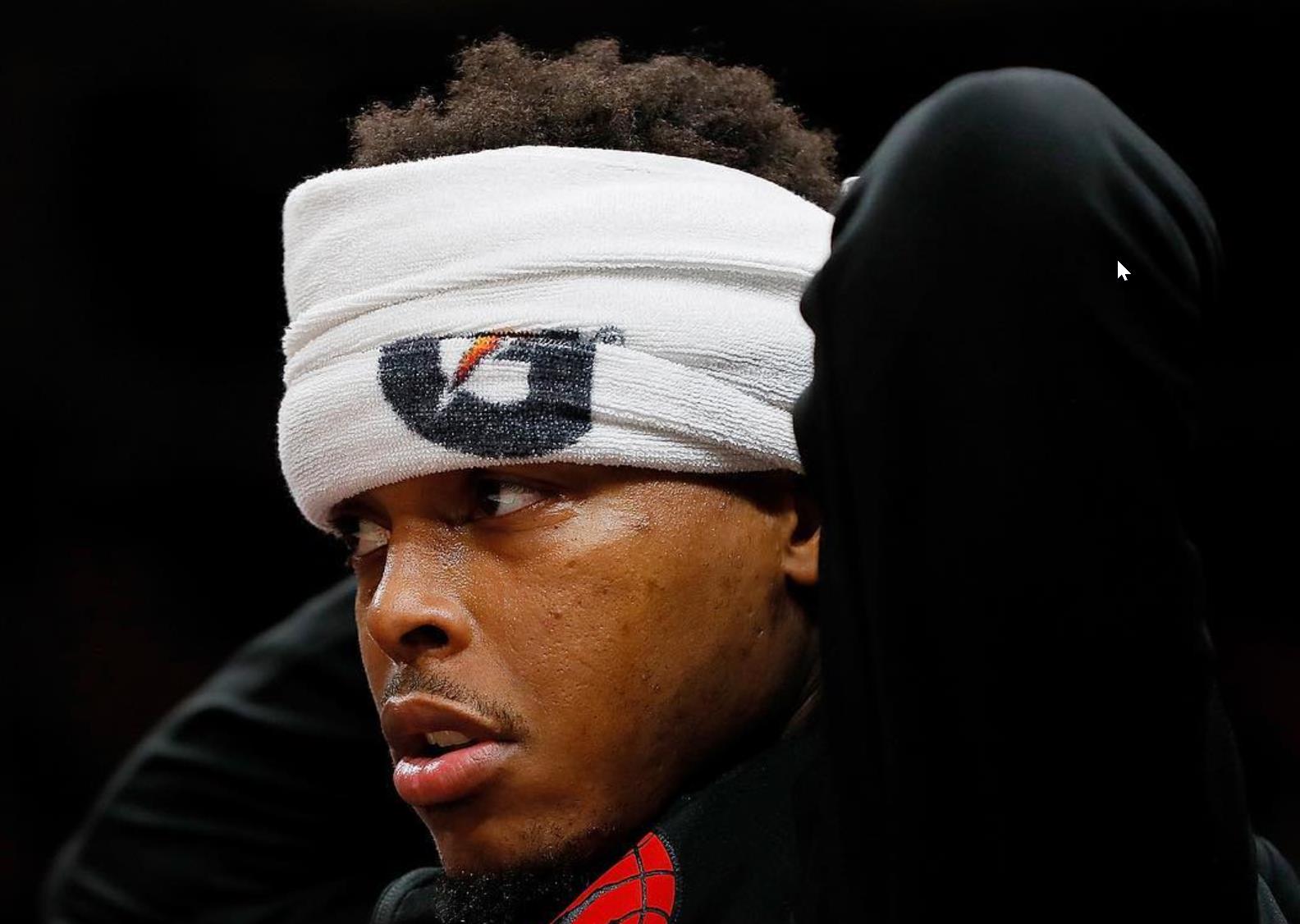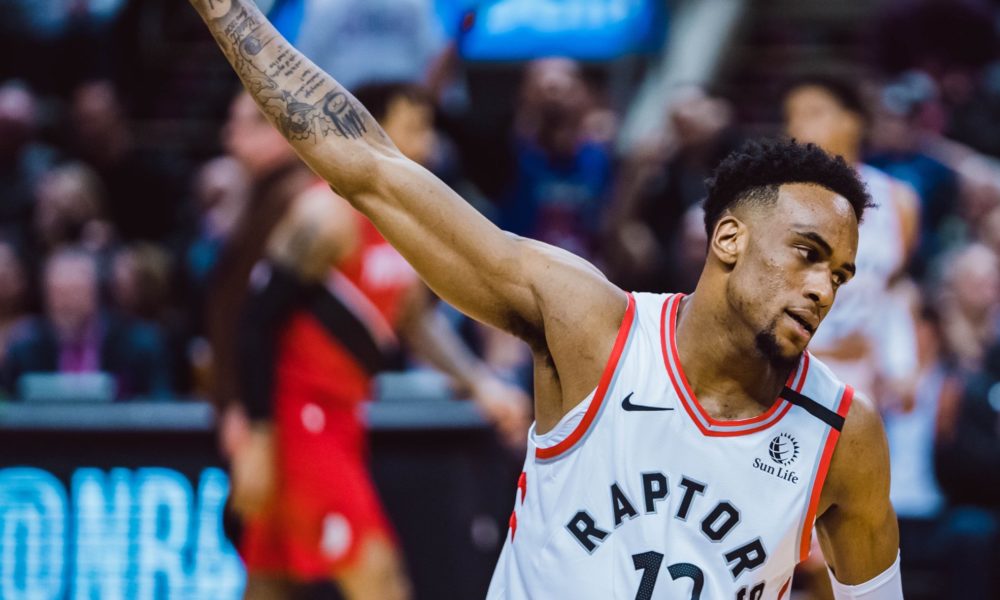Nurse still got the hat on inside.
KLow’s big on pilates & foam rolling. This week our S&C coach Jonny Lee focuses on strengthening & recovery in V5 of the Raps ISO Challenge. #NBATogether | #WeTheNorth pic.twitter.com/yAD5snuuKi
— Toronto Raptors (@Raptors) April 20, 2020
Hollinger: Five takes on NBA Draft prospects where I’m against the consensus – The Athletic
One of my pet theories that I developed while on the front office side is that players from the Intermountain West and Pacific Northwest are systematically underscouted. It’s just too challenging and time consuming for most scouts and executives to get to games in this region.
That, in turn, often leads to those same players being underdrafted … particularly if they aren’t playing for one of the bluebloods and weren’t on the hype list coming out of high school. Recent examples include Pascal Siakam (27th pick from New Mexico State), Kyle Kuzma (27th, Utah), Derrick White (29th, Colorado), Dejounte Murray (29th, Washington), Delon Wright (20th, Utah), Larry Nance, Jr. (27th, Wyoming), Spencer Dinwiddie (38th, Colorado), and of course I’m gonna mention Dillon Brooks (45th, from Oregon, after he posted a PER of 30 in Pac 12 play as a junior and took his team to the Final Four).
Anyway, this year my number one Bad Geography Guy is Sam Merrill from Utah State. To the extent he’s been mentioned at all, he’s been posited as a late second-rounder … which means that nobody is bothering to make a special trip to Logan, Utah, to see this dude play.
To be sure, there are concerns here. Merrill is average at best defensively, even in college, and he may turn out to be too flammable at the pro level for his offensive value to offset.
That said, his production and skill level suggest his draft stock is far too low. Let’s start with the fact that in our quest to find the next Duncan Robinson or Davis Bertans, someone who can launch multitudinous 3s with 40 percent accuracy, Merrill has some serious possibilities. He shot 41.0 percent from 3 and 89.3 percent from the line last season, and his career numbers from 3 are even better (42.0 percent). This wasn’t cherrypicking either — many of his attempts were off the dribble because he was the team’s primary shot-creator, and he was a volume launcher who took nearly seven a game. He has a great shot fake, too.
We’ve had a lot of good college shooters, however, and many of them were unplayable at the NBA level. The difference in Merrill’s case is how good he is on the ball for his size. He’s a 6-5 guard who appears to have decent length, and is extremely comfortably coming off of curls and playing in pick-and-rolls. While he doesn’t have the dynamism to get to the rim consistently, even with a screen, he makes the right decision darn near every time. He played in the mid-major Mountain West Conference, but the tape says that even in games against athletic SEC teams like Florida and LSU he was the best player on the court.
Michael Jordan Will Now Interrupt Your Quarantine – WSJ
Driving the excitement, of course, is the circumstance. The planet is in a drastically different place, as is ESPN. The network has no pro basketball, no college basketball, no baseball, no golf, no games to air. “The Last Dance” is the network’s biggest move left. The doc was originally supposed to air in June, amid the NBA Finals; instead, it’s been scrambled together for a national sports fix during shelter-in-place. One imagines a Wonka-like assembly of editors, sleeping little, stitching together clips—get me some Bill Wennington, stat!—in order to get it ready for its accelerated premiere. The bet is that “The Last Dance” will become a cultural moment—“ ‘The Thorn Birds’ of sports documentaries,” as the Ringer’s cheeky Bryan Curtis called it.
(Briefly: I do want to say something about the notion that there is “nothing” happening in sports, because it’s lazy nonsense. It’s true there are no games, no stats, no playoffs on the verge. But sports news? There’s never been more. The pandemic shutdown is nothing less than the most seismic disruption in the history of sports. The economic impact of what’s happening now will be vast; the way games at every level will be played and viewed is likely to change forever. Every athlete on earth will remember this time for the rest of their lives. If you’re claiming “nothing is happening” in sports—or, worse, you’re one of the media executives out there using the pandemic to cull the herd—you should hang up your helmet and probably try something else. OK end rant.)
As for “The Last Dance,” I watched. Of course I did. And from the start, director Jason Hehir’s doc slips on like a warm sweater. The doc is putatively about the conflict that nearly tore apart the 1997-98 Bulls season—in particular Jordan’s combative relationship with the club’s late general manager, Jerry Krause—but the first two episodes mostly delivered a comforting blast of nostalgia. How wondrous it was to see the lithe Jordan springing about in the Superdome during North Carolina’s 1982 title game with Georgetown! How about gobsmacked Larry Bird after a young Jordan dumped 63 on the mighty Celtics in Boston?
Who doesn’t love watching Michael Jordan play basketball? Come on. It’s like making a case against pizza.
If you remember this stuff, you remember it—for crying out loud, this was only 22 years ago, this isn’t a history of the Camden Skeeters—but now there’s a vault’s worth of never-seen-before footage, because the Bulls sanctioned a camera crew to follow the team’s closing campaign.
Report: Mamba Sports Academy a possible home for G League ‘Select Team’ – Sportsnet.ca
The G League’s Select Team was introduced to offer top-level prospects the chance to train and develop professionally instead of attending college or playing overseas.
Prospects who choose to play for this Select Team will be compensated 500,000-plus for playing in the one-year development program, according to Adrian Wojnarowski of ESPN.
Jalen Green, a five-star recruit and legitimate candidate to be the top pick in the 2021 NBA Draft, was the first player to announce he would be choosing the G League’s program instead of taking the NCAA route.
Another five-star recruit, Isaiah Todd, will also join the G League team in Southern California.
Former Toronto Raptors head coach Sam Mitchell, as well as ex-NBA coaches David Fizdale and Brian Shaw, are reportedly in the running to become the team’s coach, Haynes reported. Mitchell appears to be a favourite due to his history coaching Green in AAU.
Most casual Toronto Raptors fans have no clue who Dewan Hernandez is. For those who are unfamiliar, Hernandez was the 59th overall pick in the 2019 NBA Draft, Toronto’s only selection in last year’s draft.
Hernandez sprained his ankle in December in a game against the Cleveland Cavaliers and hasn’t been seen since.
Why is that noteworthy? Because Terence Davis, who almost every Raptors fan is aware of, would probably be the answer most would give to the question, “Who did the Raptors pick in the 2019 draft?” Davis, however, wasn’t drafted by the Raptors. Rather, he signed with the team as an undrafted, unrestricted free agent after one game with the Denver Nuggets at Summer League.
Davis showed promise in the preseason and it didn’t take long for Raptors fans to realize that head coach Nick Nurse would have to find minutes for the new kid on the block.
In his first NBA game on opening night, Davis came off the bench giving Toronto a much needed shot in the arm with five points, five rebounds and two steals in 15 minutes to help them get past the New Orleans Pelicans.
Since then, Davis has done something no other Raptor has – played in every single game this season.
It has been well-documented that the Raptors have seen their fair share of injuries and multiple players have stepped up in the time of need. But durability should be celebrated in the era of load management, and Davis has been someone to count on every time Nick Nurse was ready to set his lineup for the night.
Michael Jordan found his kryptonite in Toronto
While Michael Jordan may be the NBA’s most prolific scorer, there seemed to be one team that had his number.
Aside from the Chicago Bulls, no NBA team held Jordan to fewer points per game than the Toronto Raptors.
In 19 games against Toronto, Jordan averaged just 20.5 points per game, nearly 10 points below his career average of 30.1.
While the stat is a little skewed due to its small sample size and the fact that the Raptors only joined the NBA in 1995, toward the back half of Jordan’s 15 year career, 20.5 points per game was still six points below his scoring average in his final five seasons.
The worst scoring night of Jordan’s career also came against the Raptors. On December 15, 2002 — just two months before his 40th birthday — Jordan turned in a two-point performance in his final game in Toronto. Despite his off night, Jordan’s Wizards still knocked off the Raptors, 95-82 and he nearly recorded a double-double with nine assists and eight rebounds.
Three months later, Jordan had another off night against Toronto. He scored just four points — the third lowest of his career — on March 4, 2003, in just 14 minutes played.
Strangely, between 1995 and 2001, Jordan averaged just 22.5 points in six games against the Vancouver Grizzlies, which was his lowest against any team aside from the Bulls and Raptors.
Maybe there was something about playing Canadian teams that threw Jordan off his game a little.
Comment
Let’s Remember Some Toronto Raptors: Roko Ukić, the forever hopeful – Raptors HQ
His Raptors Run
In true Toronto fashion, the Raptors invested in Ukić in 2005 despite the fact that he was already 24 years old upon joining the team in 2008. Listed at 6’5” and 180 pounds, Ukić played like an uptempo version of Jose Calderon, already on Toronto, but for one small problem: he couldn’t shoot at all. Ukić put up averages of 4.2 points and 2.1 assists in 12.4 minutes per game that year. But he only shot 38 percent from the field and 18 percent from three.Still, Ukić appeared in 72 games during his rookie season, and played as Toronto’s back-up point guard behind Calderon by dint of being the only other usable player in that spot on the roster. (We will decidedly not be remembering Marcus Banks in this series.) Naturally, there were moments when we thought Ukić would break out. He put up 12-and-7 against the Magic one night, posted a career-high 22 points while taking on the Spurs, and even reached 10 assists for one magical night against the Thunder.
This all seems like microscopically small potatoes now, but we really did want Ukić to become if not a star in Toronto’s future, then at least a steady contributor to a good team. The Raptors were already heading into a phase of treading water (or drowning), in the midst of a 33-49 year. And even absent Ukić the following season, they’d only improve to 40-42 in 2009-10. There wasn’t a lot of hope to go around at the time.
In that spirit, it becomes clear why Ukić felt so important to fans. If the Raptors could manage to find help with the 41st pick in the draft, if they could develop an actual player, maybe the franchise wasn’t in such bad shape after all. Maybe they could turn things around. Maybe it was possible they’d get better soon.
Alas, as we know now, it was not to be for a few more years.



